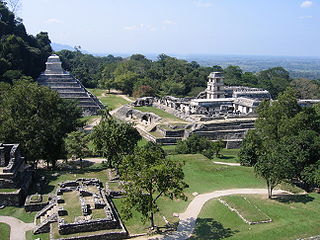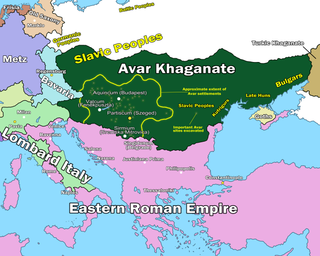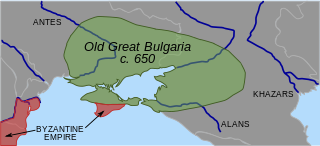
Alboin was king of the Lombards from about 560 until 572. During his reign the Lombards ended their migrations by settling in Italy, the northern part of which Alboin conquered between 569 and 572. He had a lasting effect on Italy and the Pannonian Basin; in the former, his invasion marked the beginning of centuries of Lombard rule, and in the latter, his defeat of the Gepids and his departure from Pannonia ended the dominance there of the Germanic peoples.
Year 568 (DLXVIII) was a leap year starting on Sunday of the Julian calendar. The denomination 568 for this year has been used since the early medieval period, when the Anno Domini calendar era became the prevalent method in Europe for naming years.
The 560s decade ran from January 1, 560, to December 31, 569.
566 (DLXVI) was a common year starting on Friday of the Julian calendar. The denomination 566 for this year has been used since the early medieval period, when the Anno Domini calendar era became the prevalent method in Europe for naming years.

Year 599 (DXCIX) was a common year starting on Thursday of the Julian calendar. The denomination 599 for this year has been used since the early medieval period, when the Anno Domini calendar era became the prevalent method in Europe for naming years.

The Pannonian Avars were an alliance of several groups of Eurasian nomads of various origins. The peoples were also known as the Obri in chronicles of Rus, the Abaroi or Varchonitai, or Pseudo-Avars in Byzantine sources, and the Apar to the Göktürks. They established the Avar Khaganate, which spanned the Pannonian Basin and considerable areas of Central and Eastern Europe from the late 6th to the early 9th century.

The Gepids were an East Germanic tribe who lived in the area of modern Romania, Hungary and Serbia, roughly between the Tisza, Sava and Carpathian Mountains. They were said to share the religion and language of the Goths and Vandals.

In ancient times, Romans exploited the gold mines in what is now Transylvania extensively, building access roads and forts to protect them, like Abrud. The region developed a strong infrastructure and economy, based on agriculture, cattle farming and mining. Colonists from Thracia, Moesia, Macedonia, Gaul, Syria, and other Roman provinces were brought in to settle the land, developing cities like Apulum and Napoca into municipiums and colonias.

Pannonia was a Byzantine province, which existed in present-day Syrmia region of Serbia in the 6th century. Its capital was Sirmium.

The Kutrigurs were a Turkic nomadic equestrian tribe who flourished on the Pontic–Caspian steppe in the 6th century AD. To their east were the similar Utigurs and both possibly were closely related to the Bulgars. They warred with the Byzantine Empire and the Utigurs. Towards the end of the 6th century they were absorbed by the Pannonian Avars under pressure from the Turks.
Maurice's Balkan campaigns were a series of military expeditions conducted by Roman Emperor Maurice in an attempt to defend the Balkan provinces of the Roman Empire from the Avars and the South Slavs. Maurice was the only East Roman emperor, other than Anastasius I, who did his best to implement determined Balkan policies during Late Antiquity by paying adequate attention to the safety of the northern frontier against barbarian incursions. During the second half of his reign, the Balkan campaigns were the main focus of Maurice's foreign policies, as a favourable peace treaty with Persian Empire in 591 enabled him to shift his experienced troops from the Persian front to the region. The refocusing of Roman efforts soon paid off: the frequent Roman failures before 591 were succeeded by a string of successes afterwards.

Cunimund was the last king of the Gepids, falling in the Lombard–Gepid War (567) against the Lombards and Pannonian Avars.
Thurisind was king of the Gepids, an East Germanic Gothic people, from c. 548 to 560. He was the penultimate Gepid king, and succeeded King Elemund by staging a coup d'état and forcing the king's son into exile. Thurisind's kingdom, known as Gepidia, was located in Central Europe and had its centre in Sirmium, a former Roman city on the Sava River.
Mezamir was the chieftain of the Antes, an early Slavic tribal confederation in Eastern Europe, believed to have been active around the year 560, at which time the Avar expanded further into Europe. He was the son of Idariz, and had a brother, Kelagast. Mezamir was recorded by Menander Protector. Mezamir was described as "powerful", and had most likely established a Slavic confederation sometime before the 560s, which initially thwarted the Avar khaganate. At this time, the Antes were subject to the Byzantine Empire, ruled by Justinian I, with the supreme chieftain holding the Byzantine title of archon. The Antes were given old Roman towns and stipends, in exchange for securing the Danube from the Huns, and other Barbarians. At this time, the Antes held an "extensive polity, capable of military mobilization against the Avars." The Avars were ruled by khagan Bayan I, and they used to pillage the Antes land, which at the time was neighbouring the Kutrigurs, who were Avar allies. After the Avars had ravaged and plundered the Antes, Mezamir was sent as an envoy to the Avars, to negotiate the ransom of captured Antes tribesmen. At the talks, Mezamir appeared to be a "loudmouth braggart" who spoke arrogantly and rashly; upon feeling that Mezamir became more arrogant than suitable for an envoy, a Kutrigur Bulgar who was a "friend of the Avars" and "hostile to the Antes" persuaded the Khagan that:
This man is the most powerful of all amongst the Antae and is able to resist any of his enemies whomsoever. Kill him, and then you will be able to overrun the enemy's land without fear.

Old Great Bulgaria, also often known by the Latin names Magna Bulgaria and Patria Onoguria, was a 7th-century Turkic nomadic empire formed by the Onogur-Bulgars on the western Pontic–Caspian steppe. Great Bulgaria was originally centered between the Dniester and lower Volga.

The siege of Sirmium in 580–582 was a decisive event in the history of the Balkans. The fall of the city to the Avars deprived the Byzantine Empire of its major stronghold on the northwestern Danube, opening the path for devastating incursions by the Avars and their Slavic allies into the Balkans.

In 566, Lombard king Alboin concluded a treaty with the Pannonian Avars, to whom he promised the Gepids' land if they defeated them. The Gepids were destroyed by the Avars and the Lombards in 567. Gepid King Cunimund was killed by Alboin himself. The Avars subsequently occupied "Gepidia", forming the Avar Khaganate. The Byzantine Emperor intervened and took control of Sirmium, also giving refuge to Gepid leader Usdibad, although the rest of Gepidia was taken by the Avars. Gepid military strength was significantly reduced; according to H. Schutz (2001) many of them joined Lombard ranks, while the rest took to Constantinople. According to R. Collins (2010) the remnants were absorbed either by the Avars or Lombards. Although later Lombard sources claim they had a central role in this war, it is clear from contemporary Byzantine sources that the Avars had the principal role. The Gepids disappeared and the Avars took their place as a Byzantine threat. The Lombards disliked their new neighbours and decided to leave for Italy, forming the Kingdom of the Lombards.
Usdibad was a Gepid military commander (dux) and fugitive that received refuge by Byzantine Emperor Justin II during the Lombard–Gepid War (567).

The Avar–Byzantine wars were a series of conflicts between the Byzantine Empire and the Avar Khaganate. The conflicts were initiated in 568, after the Avars arrived in Pannonia, and claimed all the former land of the Gepids and Lombards as their own. This led to an unsuccessful attempt to seize the city of Sirmium from Byzantium, which had previously retaken it from the Gepids. Most subsequent conflicts came as a result of raids by the Avars, or their subject Slavs, into the Balkan provinces of the Byzantine Empire.

The Avar Wars were fought between Francia and the Avar Khaganate in Central Europe from 788 to 803, and ended with the Frankish conquest of the khaganate's western regions. The first conflicts between the Avars and the Franks occurred in the 560s, shortly before the Avar conquest of the Pannonian Basin. Armed conflicts between the two powers were not unusual during the following centuries.











